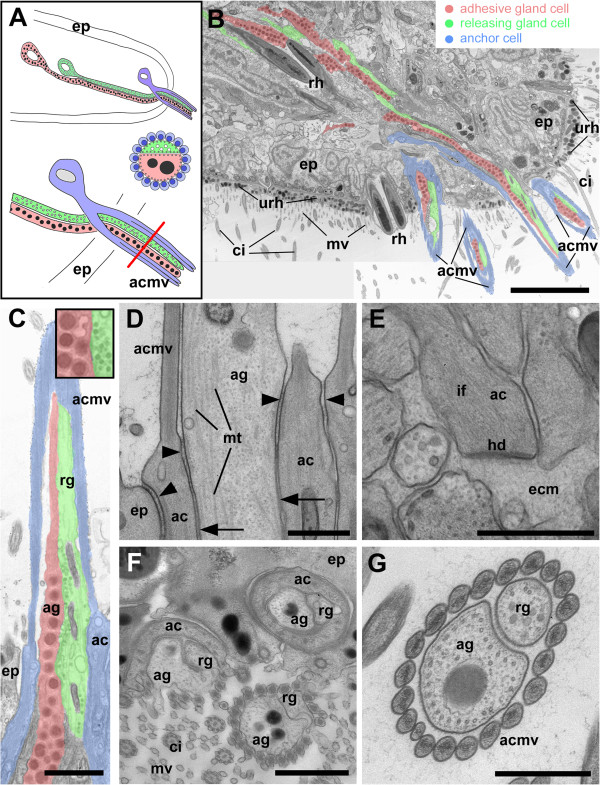Figure 3.
Overview and fine structure of the M. lignano adhesive organs. Schematic illustration (A) and transmission electron microscopy (cryo-processed specimens) (B-G). (A) Localization of adhesive organ cell types: anchor cell (blue); adhesive gland (red); releasing gland (green). The red line indicates the level of the cross section of the adhesive papilla. (B) Sagittal section of the tip of the M. lignano tail plate. Four adhesive organs are visible and several gland cell necks reach into the tail plate. (C) Sagittal section of an adhesive organ. Inset: detail of respective vesicle types. (D) Section showing strengthened adherens junctions (arrowheads) and septate junctions (arrows) between an epidermal cell and an anchor cell and between an adhesive cell and an anchor cell. Note: microtubules (mt) within the adhesive gland. (E) Basal cytoplasmic extension of an anchor cell (ac) with intermediate filaments (if); the cell is connected to the extracellular matrix (ecm) via a hemidesmosome (hd). (F) Horizontal section through adhesive organs and an epidermal cell (ep) with cilia (ci) and microvilli (mv) protruding from the epidermal surface. Three adhesive organs are sectioned at different levels. Note that the anchor cell (ac) surrounds the adhesive gland (ag) and releasing gland (rg) cells in a donut-shaped manner, i.e. without cytoplasmic interruption. (G) Cross section through an adhesive organ with central adhesive gland (ag) and releasing gland (rg) cells surrounded by a collar of microvilli of the anchor cell (acmv). ac anchor cell; acmv anchor cell microvilli; ag adhesive gland; ci cilium; ecm extracellular matrix; ep epidermis; hd hemidesmosome; if intermediate filaments; mt microtubules; mv microvilli of regular epidermal cells; rg releasing gland; rh rhabdite glands, ultrarhabdites (urh). Scale bars (A) 5 μm, (C,F) 1 μm, (D,E,G) 0.5 μm.

